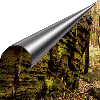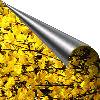

 | Wolinski National Park |  |




 | Wolinski National Park |  |


The symbol of the Park is the white-tailed eagle (Haliaeetus albicilla) often called eagle [in Polish: "orzel", less often "birkut" or "lomignat" ["bone-crusher"]) which belongs to the class of diurna birds of prey.
Wolinski National Park was established on March 3,1960 on the Wolin Island. This is the largest island lying entirely within the Polish boundaries. The Park extends over an area of diverse landscape of rare beauty, where picturesque sand dunes and the steep cliffs present a striking contrast with the hills of the island. In the year 1996, the Park's area was doubled and now stands at 10,937 ha, with forests covering 4,500 ha (41 %). Apart from its scientific, protective and cultural functions, the Wolinski National Park serves an educational purpose. The well known sea-side resort Miedzyzdroje, is located on the outskirts of the Wolinski National Park, and is a convenient starting point for interesting excursions into the heart of the Park.
Natural values
An exceptional place in the Wolin landscape is occupied by its morphologically diversified coastal zone on the Baltic side, with well developed cliffs. The relief of the earth's surface is the effect of the Scandinavian glaciation, which receded from this territory some 12 thousand years ago. Glacial moraines form the older Pleistocene nucleus of the island, which is surrounded by younger, alluvial dunes and peat bogs. The difference in the landscape of these two parts of the island may easily be noted by observing the strip of coast from the pier in Miedzyzdroje. Extending to the west, there is large crescent of a fine beach with low sandhills in the background, while to the east there are wooded hills, dropping steeply towards the sea. The highest of these hills, Grzywacz (115 m above sea level), is the highest point on the whole Polish coast of the Baltic Sea. The Park area encompasses mainly the elevated, central part of the island, which constitutes an undulated surface of a frontal moraine, descending by steep precipices towards the sea on the north, and to the Szczecin Bay in the south. Numerous erratic stones may be found on the moraine surface.
The 11.7 km long Wolin cliffs are a fragment of the 45 km zone of active cliffs on the Baltic coast. The most beautiful and the steepest part of the cliff is located east of the Grzywacz hill. The cliff sections are built of two series of till:
Overlying the till series are glaciofluvial sands and eolian cover sands, separated by the two horizons of fossil soils, which come from Allerod and Sub-Atlantic periods. The oldest cover sand series rests on a shear plane represented by a residual pavement. In cliff coast sections with sandy structures, the sand-gravel series attains a thickness of up to 40 m. The cliff is constantly being eroded by sea waves during storms and by wind deflation. As it is evaluated by geomorphologists, the sea shore has receded 150 m for the last 190 years, i.e. some 80 cm per year. The contemporary morphodynamics of the Wolin cliffs is dependent on the local hydrometeorological and lithological factors, as well as on the plant cover and human activity. The development of the Wolin cliff coasts proceeds towards an abrasion equilibrium profile, with cliff retreating continuously. This process varies over space and time.
- brown Baltic till and
- grey Middle Polish till.
At the water level (at places in cliff sections), the shoreline is only several meters wide and is covered with rock boulders, frequently of significant size. However, the flat stretch of the seashore, with its wide, sandy beach and low dunes in the back, is the main attraction of the Miedzyzdroje resort.
Vegetation
The forests of the Wolinski National Park invite for very pleasant walks. Most of the Park area is covered with mixed and deciduous forests. Among these, old, primeval-like beech forests, deserve special attention. The most precious portions of these forests are Pomeranian beech woods, (Melico-Fagetum; 18 % of all forests), and mixed forests (Fago-Quercetum) with beech, oak (6 %) and pine (74 %). The best preserved forest sections are under strict protection in reserves (total of 165 ha or 1.5 % of the Park area). They include :
The last, unusually picturesque reserve contains some xerophyte communities.
- the Dr. Stefan Jarosz Reserve, which protects the easternmost beech wood surrounded by pine wood;
- the Prof. Marian Raciborski Reserve, covering the most interesting part of the mixed forest with a multitude of woodbine and some twin-flower;
- the Prof. Zygmunt Czubinski Reserve, which protects the most beautiful portion of the orchis beech wood in the Wolinski National Park;
- the Dr. Bohdan Dyakowski Reserve, which covers a fragment of an old beech wood with a melic grass;
- the Prof. Wladyslaw Szafer Reserve, which protects a fine section of an old beech wood with Dentaria toothwort;
- the Prof. Adam Wodziczko Reserve, protecting the high cliff of the Szczecin Bay.
The old beech wood on the cliffs is rich in sumptuous orchids. Another frequent and gorgeous specimen on the cliff is the red helleborine (Cephalanthera rubra). The dunes are sparsely overgrown with vegetation, of which the most beautiul is the sea holly. This fine willow-green plant, resembling thistle, can adapt to the extremely hard environment of the dunes. The total number of all plant species is over 13 000.
Fauna
The Wolinski National Park is a habitat of many animal species. The rich world of insects on the island includes the largest Polish beetle - the stag beetle. An ornithologist could find a veritable bird paradise, with a large number of birds (ca. 200 species).
The white-tailed sea eagle, whose image is in the emblem of the Wolinski National Park, finds its favorite hunting ground here. The wing-span of this huge European bird of prey can reach as much as 2.5 m. This fine bird is under strict protection. During the recent years, its population has decreased significantly. Of the two or three pairs nesting every year in the Park, only one, at best, has young.
Other birds of prey include kite, sparrow hawk, goshawk, and buzzard. The island location provides favorable conditions for numerous species of waterbirds such as sea-gull, cormorant, mute swan, tern, grebe, the some species of duck, including the beautifully feathered shelduck.
The Park is also known for its bison reserve, established here in 1976. Roe-deer and wild boar are among the larger mammals, that may be encountered in the forests.
Other attractions
To a naturalist, the blue tourist route, which meanders through the woods south of Miedzyzdroje to the Szczecin Bay's shore, is of special interest. Hiking through the picturesque scenery of this part of the Park enables the visitor to encounter many of the exciting animal and plant species. The charming, sunny shore of the Szczecin Bay, east of the Lubin village, is high and steep. Zielonka hill at Lubin offers the most beautiful panoramic view of the Old Swina river marshes, with numerous islands (for example Karsibor) and the Szczecin Bay.
Not far from the Szczecin Bay shore, lies the village of Wapnica. Huge banks of cretaceous chalk, which were brought here by the continental glaciation during the last glacial period, are occured among the moraine tills. In the old days, these chalk sheets were partially exploited, and a small lake with a white precipice rising above its water was formed in one of the local ancient mines. This lake is known as Turkusowe (turquoise), because of its crystal clear water, which on a sunny day has a splendid emerald or turquoise color.
Nearby the Turkusowe lake, in the village of Wapnica, a giant, ancient oak grows. Such magnificent trees can be encountered in other parts of the island, for example in Miedzyzdroje, or on the shore of the Bay, west of the Karnocice village. They, apparently, are the last remnants of the virgin forests, which once covered the Wolin Island.
On a rainy day, tourist should visit the Park Museum and Ecological Center at Miedzyzdroje, which displays the interesting collections, presenting the island's natural history. Anyone, who has ever seen the Park, will certainly return to it, since it offers excellent conditions for relaxation. Every year, over 300 000 visitors are drawn to this Park, in hopes of discovering some new, enchanting treasures in this magnificent nature paradise.



If you know any WWW sites that reference Polish National Parks please e-mail them to me.
Your input will be greatly appreciated.